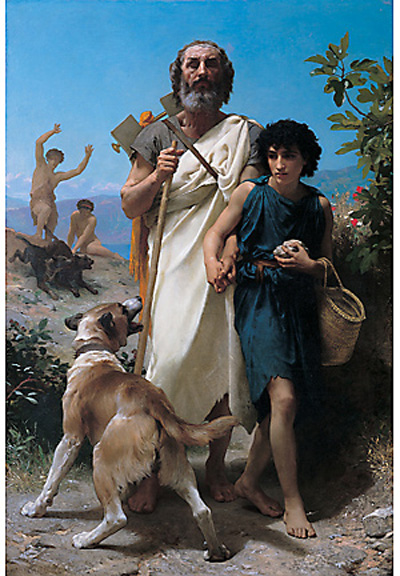From Raymond Rudorff, Belle Epoque -- The Artistic Revolution, Part 1
Rudorff presents a general -- and generally quite negative -- view of the official artistic world of Paris in the late 19th century. As you read it, think about the roles that art played in French society and the ways that those roles helped shape what options were available to French artists.
Alexandre Cabanel, Expulsion of Adam and Eve, Paradise Lost (1867) |
The kind of painting, sculpture, furniture, interior decoration and architecture in favour with most Parisians who could afford them was distinguished by academic traditionalism, a nostalgia for past styles and a total lack of imagination. In the paintings which the prosperous bourgeois admired in exhibitions or hung on his walls, the emphasis was on a nearly photographic realism and on subject matter. A painting had to be “well done” and the subject represented had to be "picturesque'', "dramatic" or “moving". Most of the paintings produced were narrative scenes, historical or military, sentimentally contrived incidents from everyday life, portraits or illustrations of Greek and Roman legends, the last being good pretexts for representations of the nude. Such paintings were no different in style and spirit from those that could be seen in homes and art galleries and in thou sands of engraved reproductions in Berlin, Vienna, Brussels, Rome or London. Where Paris differed from other capitals was in its attraction for art students from all over the world-lured to the city by its Bohemia and uninhibited student life-and in the exceptional degree of official respect paid to the most popular artists.
The last three decades of the 19th century in Paris saw the apotheosis of the great masters of what is now known as "official'', "Salon" or "academic" art. The art they produced faithfully reflected the standards, tastes and ideals that prevailed among France's middle and upper classes, and in return for their paintings they were lionised in society and honoured by the state.
The works of most of these painters have long been forgotten or if they are occasionally resurrected it is because of their curiosity value, their "quaintness" or because of the light they throw on the social history of the time. But the life and civilisation of the late 19th century cannot be fully appreciated if we ignore them because such works were more typically representative of the society that produced them than those of the revolutionary artists. The chers maltres [“dear masters”]of the Belle Epoque [“Beautiful Epoch” – the term used by the French in the 20th century to idealize the decades just before the outbreak of World War I in 1914] are as much part of the background of 1890's life in Paris as the horse carriage, the Second Empire-style architecture of the boulevards, the bustles and frills of elegant ladies and the general air of comfortable opulence that older generations have recalled with much nostalgia.
The governments of the Third Republic decided that, like Louis XIV and Napoleon III, they too would be great patrons of the arts. It was a chauvinistic age and in promoting art they felt that they were promoting France's prestige as a great, powerful nation which had fully recovered from the humiliation of defeat by Prussia in 1870. The kind of painting they admired and encouraged was grandiose, huge and always resolutely realistic in style. It was the equivalent of the officially sponsored architecture of the time and the civil servants in the Ministry of Fine Arts were lavish in giving
Adolphe-William Bouguereau, Admiration (1897) |

